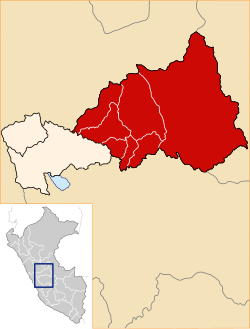10°34′26″S 75°24′18″W / 10.574°S 75.405°W
Oxapampa | |
|---|---|
 Location of Oxapampa in the Pasco Region | |
| Country | Peru |
| Region | Pasco |
| Founded | November 27, 1944 |
| Capital | Oxapampa |
| Government | |
| • Mayor | Juan Carlos La Torre Moscoso |
| Area | |
| • Total | 18,673.79 km2 (7,209.99 sq mi) |
| Population | |
| • Total | 96,169 (2,017) |
| UBIGEO | 1903 |
| Website | www |
| Year | Pop. | ±% |
|---|---|---|
| 1940 | 5,881 | — |
| 1961 | 25,783 | +338.4% |
| 1981 | 49,857 | +93.4% |
| 2007 | 81,829 | +64.1% |
| 2020 (est) | 100,561 | +22.9% |
| Source:[1][2] | ||
The Oxapampa Province (Spanish: Provincia de Oxapampa) is the largest of three provinces that make up the Pasco Region in Peru.[3] The capital of the Oxapampa province is the city of Oxapampa. The province is located on the eastern slopes of the Andes reaching down to the lowlands of the Amazon Basin. The high point of the province is approximately 5,300 metres (17,400 ft) in elevation near the summit of Huaguruncho mountain in the Huancabamba District and the low point is approximately 200 metres (660 ft) on the Pachitea River in the Constitución District.[4]
The Cerro de la Sal, an important source of salt for the indigenous people of the Amazon Basin since pre-historic times is located in the Villa Rica District of the province. The southeastern part of the province is the location of the Gran Pajonal (Great Grassland), an elevated plateau occupied by the Asháninka people.
Oxapampa is best known for the colonists from Austria and Germany who established one of the first European settlements (in Peru) east of the Andes in remote Pozuzo District in 1859 and founded the towns of Oxapampa in 1891 and Villa Rica in 1928. Germanic influence remains in the architecture and culture of these districts.[5]
- ^ Instituto Nacional de Estadística e Informática, Peru
- ^ "Chapter 8 - Human Occupation of the Central Selva of Peru". Organization of American States. Retrieved 17 June 2020.
- ^ (in Spanish) Official web site of the Oxapampa Province
- ^ Google Earth
- ^ Dilwyn Jenkins (2009-07-01). The Rough Guide to Peru. Rough Guides Limited. pp. 487–489. ISBN 978-1-84836-053-2.

